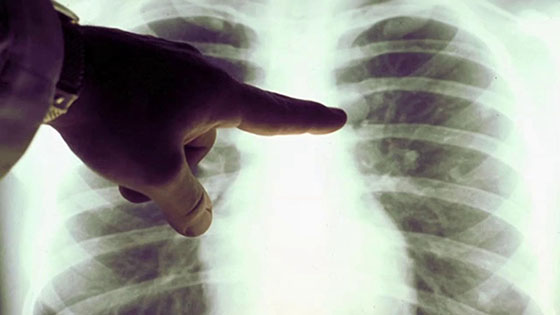by Michael R. Costello, M.D., Hematology/Oncology
The Abramson Cancer Center at Chester County Hospital
 A patient I'll call "Mary" went to her local ER with severe belly pain, thinking it was one of the worst days of her life. It would turn out to be one of her luckiest. Mary was 58 at the time and seemingly healthy. The CT scan in the ER revealed an inflamed gall bladder that had to come out, but she would be fine. However, the scan also showed a small lung nodule that needed follow up. Ultimately she saw a lung specialist (pulmonologist) and a thoracic surgeon who told her she had been lucky to have the gallbladder problem, since that incidental scan finding was a very early stage lung cancer that could likely be surgically cured.
A patient I'll call "Mary" went to her local ER with severe belly pain, thinking it was one of the worst days of her life. It would turn out to be one of her luckiest. Mary was 58 at the time and seemingly healthy. The CT scan in the ER revealed an inflamed gall bladder that had to come out, but she would be fine. However, the scan also showed a small lung nodule that needed follow up. Ultimately she saw a lung specialist (pulmonologist) and a thoracic surgeon who told her she had been lucky to have the gallbladder problem, since that incidental scan finding was a very early stage lung cancer that could likely be surgically cured.
At 50, Mary had decided to take her primary care physician's recommendations seriously -- she quit smoking, started eating better, and followed through on the usual periodic health screenings including pelvic exam, mammogram and colonoscopy with no issues. As a former smoker, Mary was high risk for lung cancer, but at the time there were no simple, safe screening tests to catch these cancers early, unlike for breast, colon and prostate cancers. As a result, and since often there are no early symptoms, many lung cancers are diagnosed after the disease has spread. Mary had lung surgery three years ago and is currently doing very well; she still counts herself very lucky.
Lung cancer is the number one cause of cancer-associated mortality, accounting for approximately 25% of all cancer-related deaths. More men and women die of lung cancer per year than of colon, breast and prostate cancers combined. According to the American Cancer Society, there were about 222,500 new cases of lung cancer and 155,870 deaths from the disease in 2017. Smoking is the single biggest risk factor for lung cancer and contributes between 80-90% of lung cancer-related deaths. Other risk factors include a personal or family history of cancer, a diagnosis of chronic obstructive pulmonary disease (COPD) or pulmonary fibrosis, and certain environmental exposure such asbestos, chromium, arsenic, diesel vapors and radon.
As with other cancers, lung cancer survival varies depending on the stage or extent when diagnosed. Early detection through screening programs has made dramatic improvements in breast and colon cancer survival. Fortunately, new findings from the National Lung Screening Trial (NLST) involving 53,454 participants show that lung cancer deaths decreased by 20% in high-risk individuals who underwent a low-dose CT scan, compared to screening by chest X-rays. Since this landmark 7-year study with was published in the New England Journal of Medicine in 2011, lung screening programs now enable physicians to diagnose lung cancer in its earliest and most treatable stages.

The screening is painless, brief (under 30 seconds), and "low dose" means less radiation than standard CT scanning (although the benefit of finding and treating early stage lung cancers in high-risk individuals far outweighs any radiation risk). A radiologist interprets the scan and makes written recommendations to the ordering physician about the need for additional testing (if any). Typically the patient also receives a letter with the results and any follow-up instructions. Screening someone without symptoms is not yet covered by most insurance companies, but out-of-pocket costs are relatively low and any follow-up care would likely be covered.
Quitting smoking or never smoking is paramount to reducing the risk of lung cancer; but low-dose CT screening may help detect lung cancer at an earlier stage and improve treatment options. Chester County, PA residents with risk factors should discuss the potential benefits of screening with their physicians.
Learn more about low-dose CT lung screens and find out if a screening is right for you.